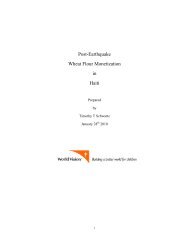BARR_Report_Ravine_Pentad_Final_v_31
You also want an ePaper? Increase the reach of your titles
YUMPU automatically turns print PDFs into web optimized ePapers that Google loves.
1.0 <strong>BARR</strong> <strong>Ravine</strong> <strong>Pentad</strong> Pilot Study<br />
1.1 <strong>Ravine</strong> <strong>Pentad</strong> MTPTC Building Assessments<br />
Prior to the survey MTPTC had evaluated most buildings in <strong>Ravine</strong> <strong>Pentad</strong>. This meant that with<br />
regard to structural assessments most buildings sampled were expected to yield usable data. In<br />
fact, 220 of the households were not marked (something that one NGO worker to them being in<br />
the red category and considered uninhabitable; 85% of them have been re-inhabited). The<br />
impact of structural assessments was captured in the Residential Building survey List (RL).<br />
Occupants were asked time of return which was compared to known time of evaluations;<br />
occupants were also their opinions regarding the quality of the survey and if survey evaluations<br />
influenced their decision to return to the dwelling.<br />
1.2 <strong>Ravine</strong> <strong>Pentad</strong> Rubble Removal Program (RRP)<br />
Under the USAID funded CLEARS program CHF removed rubble from two areas. <strong>BARR</strong><br />
collected data on occupancy rates, rubble removal activity for all residential buildings thereby<br />
providing data with which we compare re-occupancy rates for those areas within or near to the<br />
rubble removal activity versus those more remote from the rubble removal.<br />
1.3 <strong>Ravine</strong> <strong>Pentad</strong> Survey Strategy<br />
The <strong>BARR</strong> survey team set out to document the MTPTC color code for the expected N= 905<br />
residential buildings in the <strong>Ravine</strong> <strong>Pentad</strong> community (found N=708 buildings) and apply the<br />
<strong>BARR</strong> Residential Building survey instrument to all yellow and green color coded buildings<br />
(expected N=221 yellow and green buildings; found N=300). Four focus groups were conducted<br />
(6 women who have returned or never left the community; 6 men who have returned or never<br />
left the community; 6 women from the community who are living in camps; 6 men from the<br />
community who are living in camps). A Neighborhood Profile Questionnaire and a map of<br />
services and resources (water sources, rubble removal zones, electric service, latrines) and a<br />
general history, ethnographic profile, and overview of conditions in the community were<br />
completed.<br />
1.4 <strong>Ravine</strong> <strong>Pentad</strong> Survey Execution<br />
Two teams of 5 surveyors each (total = 10) worked under the guidance of two supervisors and<br />
two team leaders. They counted and documented before and after residence status of all 708<br />
buildings (those destroyed and standing) in the community. After each building was visited and<br />
the information documented, white spray paint was used to mark an “L” (for LTL) on the building<br />
or wall. All green and yellow marked homes were visited and the Residential Building<br />
Questionnaire applied.<br />
The actual data gathering took 4 days, involved 1 team leader, 1 qualitative specialist who<br />
oversaw field work and conducted focus groups and key informants interviews, 2 supervisors<br />
who managed two teams of 5 interviewers per team (10 interviewers), four vehicles and drivers,<br />
and 3 fulltime data entry personnel.<br />
<br />
<br />
<br />
One - Survey Expert and Team Leader<br />
One - Local Quantitative & Qualitative Expert<br />
Two - Supervisors<br />
3
















